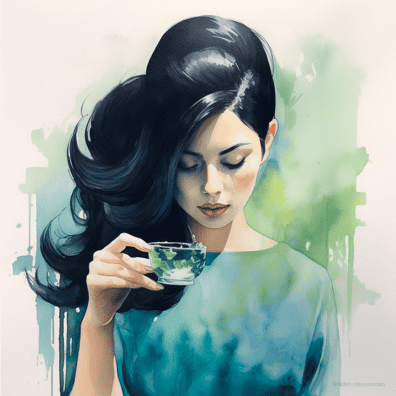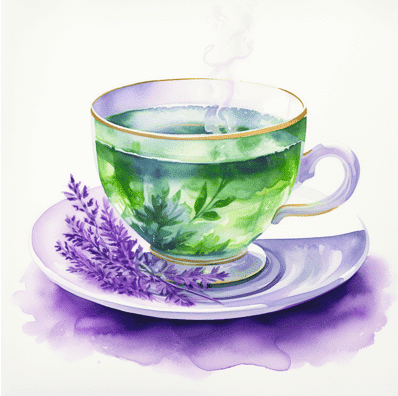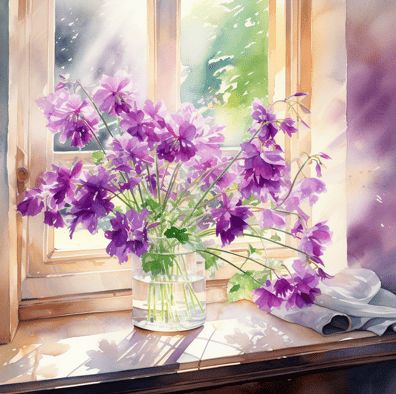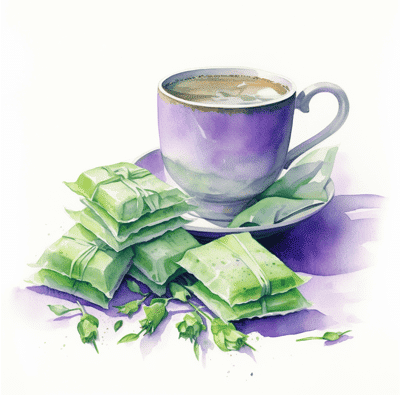
How long does green tea last?
Green tea leaves, when stored properly in a cool, dry place away from direct sunlight, can last up to 6-12 months, retaining their freshness and potency. On the other hand, brewed green tea is best consumed within a few hours, though it can last up to 24 hours in the refrigerator before losing its optimal flavour and freshness.
ABOUT ME
Be beauty. Be plant-based!
As a former Registered Nurse and avid plant-muncher, I’m in love with how simple plant-based foods make it easy to be beautiful.

You’ll also love:
Sencha vs. Matcha: Which Green Tea is Right for You?
Sipping Your Way to Radiance: Matcha Tea Bag vs Powder
Hey there, beautiful! Between managing a zillion things and chasing your dreams, you’ve stopped by to unlock the mysteries of green tea and figure out how long does green tea last. Good on you!
Let’s not dilly-dally and get to the question steeping in your mind: how long does green tea last? And while we’re at it, let’s ensure every tea-infused moment is as fresh and fabulous as you are.
How Long Does Green Tea Last?
Green Tea Bags and Leaves
Just like that chic dress in your closet, green tea has its prime time too. Whether it’s in bags or as loose leaves, green tea usually remains fresh for about 6-12 months. But, don’t solely rely on guesswork – always keep a weather eye on the expiry date!

Brewed Green Tea
Imagine this: a freshly brewed cup of green tea, steam rising, waiting just for you. But remember, it’s best enjoyed within a few hours. If you’re thinking of saving some for later, a quick tip: refrigerate it promptly. Leaving it out too long might invite unwanted bacterial growth, turning your delightful cup into something icky instead.
Influencers Behind Green Tea’s Shelf Life
Every tea leaf has its secrets, and the longevity of your green tea hinges on a few factors. Let’s unravel them:
Direct Sunlight & High Temperatures
Imagine your green tea as a delicate flower. Just like a bloom might wilt under the harsh midday sun, your green tea isn’t a fan of sunbathing either. Exposure to direct sunlight and extreme temperatures can degrade its quality, robbing you of that rich, authentic flavour.

Moisture & Bacterial Growth
Moisture to tea is what a gatecrasher is to a party—unwanted.
When tea leaves become moist, it’s like rolling out a red carpet for bacteria. They thrive in such conditions, and before you know it, your tea has turned from a refreshing escape to a microbial hub.
Always ensure your tea remains dry to preserve its freshness and integrity.
Old Tea Leaves vs. New Tea
There’s something enchanting about a fresh pack of tea: the scent, the vibrant leaves, the promise of a perfect brew. Over time, even if your tea doesn’t technically “expire”, it may lose some of its zest. That’s why the freshest batch will always offer the best aroma and flavour.
Storage 101: Making Your Tea Last
How Long Does Green Tea Last? Proper storage is like giving your tea a five-star accommodation experience. Here’s how you can be the perfect host:
Airtight Container
Picture this container as the guardian of freshness for your green tea leaves. By keeping the external elements at bay, it ensures that every brew is as mesmerising as the last.

Room Temperature & Dark Place
Just as you’d relish a cosy nook away from the hustle and bustle, your tea too enjoys a tranquil spot. Storing it at room temperature in a dark corner ensures that your tea remains in its prime for longer.
Green Tea Bags
The needs of green tea bags are a tad different from loose leaves. While they love the comfort of an airtight container, ensuring they’re stored in a dry place is key. Those little sachets are packed with flavour and deserve the best care.

Hot Tip! Tea is like a sponge for scents. Store it away from spices or any strong-smelling foods. You wouldn’t want a brew that tastes like last night’s dinner, would you?
You’ll also love:
From Bitter to Better: Distinguishing Good Matcha vs Bad Matcha
Ensuring Good Quality Tea Every Time
In the vast expanse of teas, ensuring you’re getting the best quality is akin to choosing the ripest fruit in a grove. It’s worth the effort though, for the best cup of tea.
Expiration Date vs. Expiry Date
Though often used interchangeably, they serve the same purpose – to guide you on freshness. No matter the term, it’s your first clue to understanding how fresh your tea is.
The Power of Smell
Tea has a language, and its aroma speaks volumes. A fresh tea will captivate you with its scent. If it smells off or lacks aroma altogether, it’s likely past its prime.
Shelf Life of Tea
Not all teas are woven from the same fabric. For instance, herbal and fruit teas might have a shorter shelf life compared to their pure tea counterparts. It’s always wise to acquaint yourself with the specific life span of each tea type.
Each tea, with its unique essence, promises an experience. As you navigate through them, these tips will serve as your compass, ensuring every cup is a journey worth remembering. After all, in the pursuit of beauty and health, quality is everything.
Wellness in Every Cup: The Essence of Storing Tea Right
Storing tea transcends merely holding onto its aromatic charm and rich flavours. At its core, it’s about preserving the multitude of health benefits each leaf possesses. Much like the efforts you pour into your skincare or the dedication behind that beloved yoga stretch, the best cup of tea you enjoy is a reflection of the care you invest.
Preserving Potency with Freshness
Each tea variant, be it the heart-protective antioxidants in green tea or the soothing vibes of herbal infusions, bestows a unique wellness boon. Vitamin C in some teas, renowned for its rejuvenating and protective qualities, remains most effective when the tea is fresh.
To experience these antioxidant properties and other health wonders to their fullest, proper storage is non-negotiable.

The Safety Mantra
Beyond the tantalising aroma and flavour, there’s an aspect of tea that’s often overlooked – safety.
Even the finest teas can morph from a cup of health and vitality to a haven for harmful bacteria if stored carelessly. Ensuring your teas are well-stored isn’t just a practice in savouring taste, but a testament to cherishing one’s health.
When every brew becomes a potion of wellness, understanding and practicing optimal storage becomes our homage to both the leaf and ourselves.
Have you read?
Caffeine in Irish Breakfast Tea: Boost or Bust?
Beyond Green: Exploring Different Types of Tea
As you embark on your green tea expedition, know that it’s merely the opening chapter of a riveting saga that spans the vast and vibrant world of teas. For tea lovers, each tea variety offers a distinct charm, painting portraits of diverse moods and cherished moments:
Black Tea & White Tea
These two, while being siblings to green tea, unveil distinct narratives. The rich flavour of black tea is both bold and commanding, whereas white tea murmurs its delicate tales. Think of them as two musicians, delivering contrasting yet harmoniously intertwined melodies in a concert.
Oolong Tea, Herbal Tea & Yellow Tea
Oolong, a delightful middle child between green and black tea, showcases a flavour all its own. Herbal tea, a bouquet of herbs, blossoms, and spices, might not be a traditional “tea”, but it echoes with nature’s diverse symphony in every cup. And then there’s yellow tea, often overlooked, but with a fresh flavour that’s a sheer delight.
Fruit Tea, Sweet Tea & Iced Tea
Fruit teas, kissed by nature’s sweetness, explode with vibrant and tangy tales, ideal when you’re seeking a bit more zest in your day. Sweet tea, a southern gem, wraps you in its sugary embrace. Iced tea, be it green, black, or fruit-laden, stands by you like a loyal friend on a sun-drenched afternoon, always refreshing.
Cold Brew Tea, Pu-erh Tea & Loose Leaf Teas
While fleeting trends dot the landscape, some teas are timeless treasures. Cold brew tea, known for its gentle, patient extraction, delivers a pristine taste. Pu-erh tea, an aged marvel, captivates with its depth. The realm of loose leaf teas, from the delicate chamomile to the assertive dry tea leaves, beckons every aficionado to savour tea in its unadulterated essence, one exquisite leaf after another.
In this grand tapestry of tea varieties, every sip becomes a story, every brew an adventure.
Ready for a Tea-rrific Adventure?
With every tea leaf you steep and every cup you savour, you embark on an adventure. And like all great adventures, this one is ripe with possibilities and discoveries:
Changing Your Tea Game: Venturing beyond green tea? Perhaps an oolong for that midday pick-me-up or a fruit tea for a late-night treat. Every new tea you introduce to your repertoire is a new chapter in your tea story.
How long does green tea last? The world of tea is vast, each type offering a unique escape, a moment of tranquility, and a sip of wellness. From understanding its shelf life to basking in its health benefits, every facet of your tea journey is an ode to the beautiful symphony of nature.
May your tea always be fresh, your brews always invigorating, and your moments with tea, eternally heartwarming. Because just like you, every tea has a soul, waiting to be discovered and cherished.
FAQ: How long does green tea last?
1. Can green tea go bad?
Absolutely. Like most tea types, green tea can degrade based on storage conditions. It’s essential to store it in a cool place, away from direct sunlight and moisture, to ensure a longer shelf life.
2. How can you tell if green tea has gone bad?
Green tea that’s past its prime will often have a stale flavour and might lack the fresh aroma it once had. If your tea has an off or sour smell, or if it has visible mould, it’s best to discard it. Also, an expired tea will generally have reduced health benefits.
3. Is it ok to drink day old green tea?
While it’s safe to drink day old green tea, especially if it has been stored in a well-sealed container, it might not offer the same fresh taste as a freshly brewed cup. It’s also essential to ensure that it hasn’t been sitting in hot temperatures or direct sunlight, which can degrade its quality.
4. What happens if green tea is left too long?
If green tea is brewed for too long with hot water, it can become overly bitter due to the extraction of tannins. If it’s left sitting after brewing, the flavour might become flat. For cold brew methods, the longer you leave it, the cooler and more mellow the flavour becomes.
5. Can I drink green tea that’s been sitting out?
It depends on how long and under what conditions. Green tea left out for a few hours is generally fine to drink, but if it’s been out for more than 24 hours, especially in warmer conditions, it might have started to harbour bacteria. Always store it in tea tins or a well-sealed container to retain its freshness.
6. How many times can you re-use green tea?
Green tea leaves can be re-infused multiple times, usually up to 2-3 times. With each infusion, the flavour profile might change slightly. Ensure you’re using fresh hot water with each brew. Remember, the cooler the tea, the milder the subsequent infusions will be.
Remember, the storage method plays a crucial role in preserving the qualities of green tea. Always prioritise its storage to enjoy the most refreshing cup every time.